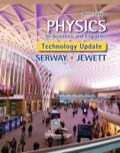
Concept explainers
Four trials of Young's double-slit experiment are
(i)
Ranking of the trials from largest to the smallest angular distance.
Answer to Problem 37.2OQ
The Ranking of the trials from largest to the smallest angular distance is
Explanation of Solution
Given info: For case (a) and case (b) the slit separation is
Write the expression for constructive interference for the bright fringes.
Here,
The value of
Substitute
Case (a);
The wavelength of the blue light is
Substitute
Thus, the value of angular distance is
Case (b);
The wavelength of the red light is
Substitute
Thus, the value of angular distance is
Case (c);
The wavelength of the red light is
Substitute
Thus, the value of angular distance is
Case (d);
The wavelength of the red light is
Substitute
Thus, the value of angular distance is
The ranking of the angular distances of all the cases is,
Conclusion:
Therefore, the ranking of the trials from largest to the smallest angular distance is
(ii)
Ranking of the trials on the basis of their distance between the central maximum and the first order side maximum on the screen.
Answer to Problem 37.2OQ
The Ranking of the trials on the basis of their distance between the central maximum and the first order side maximum on the screen is
Explanation of Solution
Given info: For case (a) and case (b) the slit separation is
Write the expression for distance between the central maximum and the screen.
Here,
Case (a);
The wavelength of the blue light is
Substitute
Thus, the value of
Case (b);
The wavelength of the red light is
Substitute
Thus, the value of
Case (c);
The wavelength of the red light is
Substitute
Thus, the value of
Case (d);
The wavelength of the red light is
Substitute
Thus, the value of
The ranking of the distance between the central maximum and the screen of all the cases is,
Conclusion:
Therefore, the ranking of the trials on the basis of their distance between the central maximum and the first order side maximum on the screen is
Want to see more full solutions like this?
Chapter 37 Solutions
EBK PHYSICS FOR SCIENTISTS AND ENGINEER
- 13.87 ... Interplanetary Navigation. The most efficient way to send a spacecraft from the earth to another planet is by using a Hohmann transfer orbit (Fig. P13.87). If the orbits of the departure and destination planets are circular, the Hohmann transfer orbit is an elliptical orbit whose perihelion and aphelion are tangent to the orbits of the two planets. The rockets are fired briefly at the depar- ture planet to put the spacecraft into the transfer orbit; the spacecraft then coasts until it reaches the destination planet. The rockets are then fired again to put the spacecraft into the same orbit about the sun as the destination planet. (a) For a flight from earth to Mars, in what direction must the rockets be fired at the earth and at Mars: in the direction of motion, or opposite the direction of motion? What about for a flight from Mars to the earth? (b) How long does a one- way trip from the the earth to Mars take, between the firings of the rockets? (c) To reach Mars from the…arrow_forwardNo chatgpt pls will upvotearrow_forwarda cubic foot of argon at 20 degrees celsius is isentropically compressed from 1 atm to 425 KPa. What is the new temperature and density?arrow_forward
- Calculate the variance of the calculated accelerations. The free fall height was 1753 mm. The measured release and catch times were: 222.22 800.00 61.11 641.67 0.00 588.89 11.11 588.89 8.33 588.89 11.11 588.89 5.56 586.11 2.78 583.33 Give in the answer window the calculated repeated experiment variance in m/s2.arrow_forwardNo chatgpt pls will upvotearrow_forwardCan you help me solve the questions pleasearrow_forward
- Can you help me solve these questions please so i can see how to do itarrow_forwardHow can i solve this if n1 (refractive index of gas) and n2 (refractive index of plastic) is not known. And the brewsters angle isn't knownarrow_forward2. Consider the situation described in problem 1 where light emerges horizontally from ground level. Take k = 0.0020 m' and no = 1.0001 and find at which horizontal distance, x, the ray reaches a height of y = 1.5 m.arrow_forward
- 2-3. Consider the situation of the reflection of a pulse at the interface of two string described in the previous problem. In addition to the net disturbances being equal at the junction, the slope of the net disturbances must also be equal at the junction at all times. Given that p1 = 4.0 g/m, H2 = 9.0 g/m and Aj = 0.50 cm find 2. A, (Answer: -0.10 cm) and 3. Ay. (Answer: 0.40 cm)please I need to show all work step by step problems 2 and 3arrow_forwardFrom number 2 and 3 I just want to show all problems step by step please do not short cut look for formulaarrow_forwardPlz don't use chatgpt pls will upvotearrow_forward
 Physics for Scientists and Engineers: Foundations...PhysicsISBN:9781133939146Author:Katz, Debora M.Publisher:Cengage Learning
Physics for Scientists and Engineers: Foundations...PhysicsISBN:9781133939146Author:Katz, Debora M.Publisher:Cengage Learning Principles of Physics: A Calculus-Based TextPhysicsISBN:9781133104261Author:Raymond A. Serway, John W. JewettPublisher:Cengage Learning
Principles of Physics: A Calculus-Based TextPhysicsISBN:9781133104261Author:Raymond A. Serway, John W. JewettPublisher:Cengage Learning Glencoe Physics: Principles and Problems, Student...PhysicsISBN:9780078807213Author:Paul W. ZitzewitzPublisher:Glencoe/McGraw-Hill
Glencoe Physics: Principles and Problems, Student...PhysicsISBN:9780078807213Author:Paul W. ZitzewitzPublisher:Glencoe/McGraw-Hill University Physics Volume 3PhysicsISBN:9781938168185Author:William Moebs, Jeff SannyPublisher:OpenStax
University Physics Volume 3PhysicsISBN:9781938168185Author:William Moebs, Jeff SannyPublisher:OpenStax



